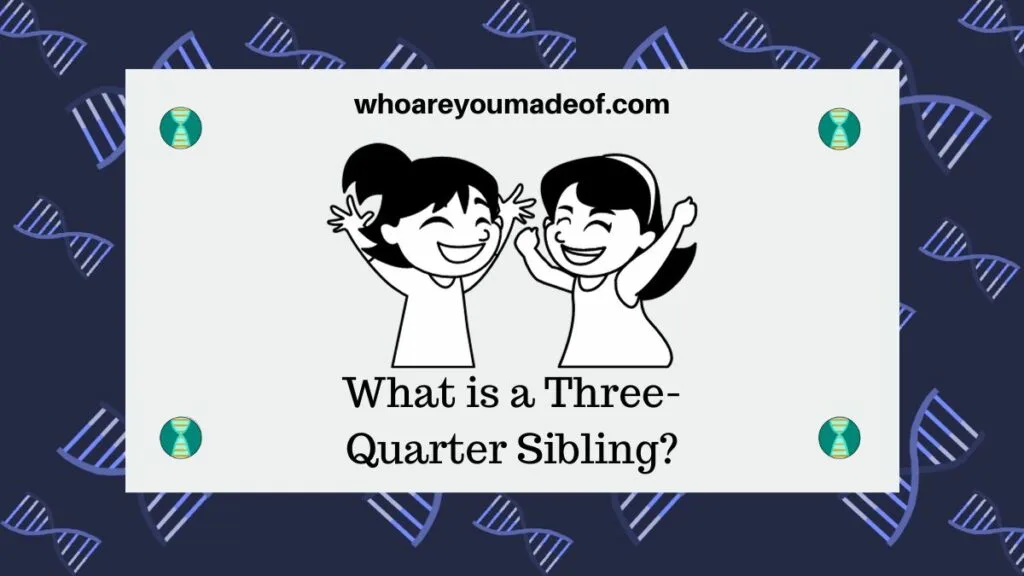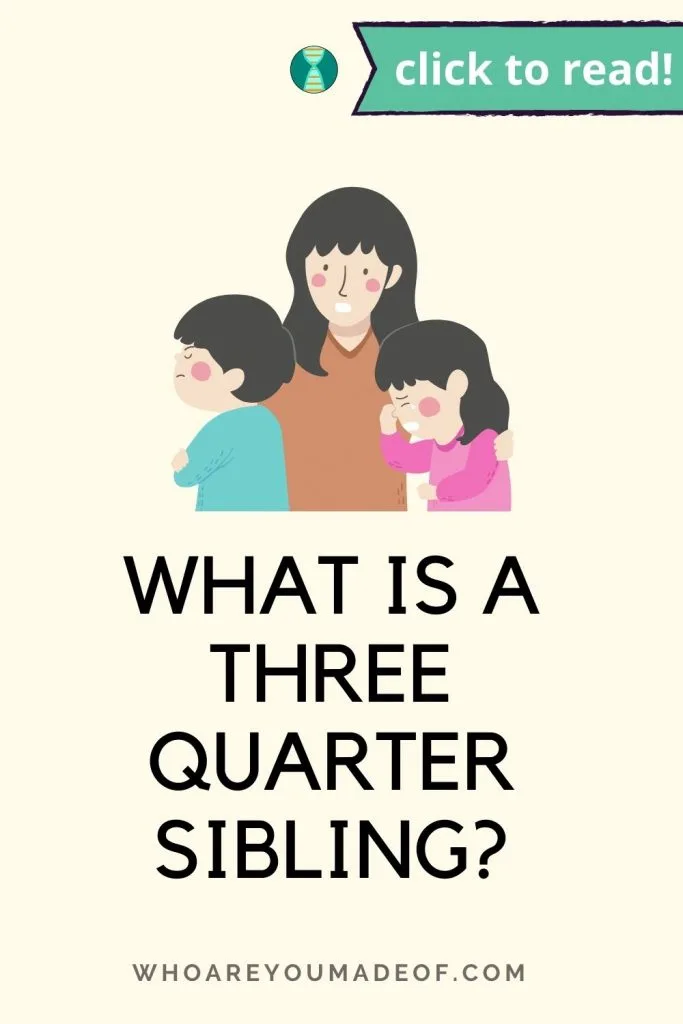Most people are familiar with the idea of a full or half-sibling, but not everyone has heard of a three-quarter sibling. In this post, you will learn what is a ¾ sibling, and how much DNA ¾ siblings typically share.

Many people have individuals who were three-quarter siblings to each other in their family tree. Once you are done reading this post, you might be able to spot three-quarter siblings in your tree, too.
Definition of a three quarter sibling
A ¾ sibling is the child of one of your parents and the sibling of your other parent. Since the three-quarter siblings are children of the other sibling's aunt or uncle, they share one parent and all four grandparents as common ancestors.
Examples of ¾ siblings
John and Beth get married, and have a child together. His name is George. John and Beth split up, and Beth's sister, Jane, stops by John's place to pick up some of Beth's belongings, and some old feelings are rekindled.
It turns out that Jane and John used to be high school sweethearts, but they went to college in different states and grew apart. John ended up marrying Beth instead, but Jane's feelings for John never went away completely.
After some time, John and Jane end up getting together, and they have a child together, who they name Sarah.
Sarah and George are ¾ siblings, since they share a father (John) and their mothers are sisters.
How common are three-quarter siblings?
Back a few hundred years ago, it was perfectly common and very acceptable for a woman whose husband had died, or a man whose wife had died, to marry the sibling of the deceased spouse.
It made sense for someone who was related by blood to the children to take on the responsibility of caring for them. The new marriage often produced more children, who were ¾ siblings of the children from the previous marriage.
Polygamous marriages, which are common in some cultures of the world - including certain parts of the United States - often include a man (or less commonly, a woman) who has been allowed to choose multiple wives (in the case of a woman, multiple husbands).
It can happen that two or more of the wives are from the same family (sisters), and the children of these relationships will be ¾ siblings because their mothers were sisters.
In my own family tree, I have at least one known example of three-quarter siblings. My great-great-great-great grandfather, born in Rhode Island in 1809, married his first wife and had four children.
His first wife died when her youngest child was two years old, and her husband then married her sixteen-years younger sister. This younger sister, who is my great-great-great-great grandmother, bore her deceased sister's husband four more children.
In this particular family, the four youngest children are three-quarter siblings to the oldest four.
Sometimes, we won't be able to find three-quarter examples out in the open in our family tree. Many people find situations where a woman had a close relationship with the brother of her spouse, or vice versa.
This can lead to questions about whether the offspring of a man or a woman are three-quarter siblings. One way to to attempt to determine whether two people are three-quarter siblings is to examine their shared DNA.
How much DNA is shared between two three quarter siblings
While full siblings will share approximately 50% of their DNA, and half-siblings approximately 25%, three-quarter siblings fall somewhere in between - about 37.5%.
In genetic genealogy, we like to use the unit of measurement called centimorgans to describe shared DNA. Using centimorgans (cMs), the average amount of shared DNA between the three types of siblings are as follows (numbers are approximate):
- Full siblings 2550 cMs
- Three quarter siblings 2125 cMs
- Half-siblings 1700 cMs
It's important to note that there is a range of shared DNA between siblings, no matter whether they are full or half (and less commonly, three quarter siblings).
The numbers listed above are just the average amount shared. Actual amounts shared between siblings at those relationship levels will vary. Some will be a little less, and some will be a little more.
Can you tell if you are a three quarter sibling just based on shared DNA?
The short answer is no. If you suspect that you and your sibling are three quarter siblings, meaning that one of you might possibly be the child of one parent and the sibling of the other parent, you cannot prove or disprove this theory simply based on your amount of shared DNA.
The reason for this is because there are ranges of shared DNA between half siblings and full siblings, and a three quarter sibling falls right within the range for both types of siblings. You wouldn't be able to say for sure, just based on the number of shared centimorgans, that a sibling is a three quarter sibling.
Do you want the long answer? By having other family members test, you might be able to become more certain one way or the other.
For example, can you test your parents, or aunt or uncle? If either of them is the parent of you or your sibling, then they should show up as a parent match on an autosomal DNA test.
If no aunt or uncle is available to test, if the aunt or uncle (the sibling of the parent who you think might be the parent of your sibling) has children, i.e. first cousins to you, then you might be able to acquire additional information by having them do an autosomal DNA test.
A sibling is a sibling
I always feel it's good to stress that how much DNA we share, or don't share, with someone doesn't have to be, and shouldn't be, the basis for how we feel about them. In some families, half siblings grow up extremely close to each other - even closer than full siblings in other families.
I have first cousins once-removed and second cousins that I feel more connected to than aunts and uncles. Relationships are what we decide to make of them.

Conclusion
I hope that this post has helped understand a little more about the concept of three quarter siblings. It isn't especially common to have a three quarter sibling anymore, but it can still happen.
There are dozens of reasons why this can end up happening in our families, and it's great to be able to put a name to it and spot it when we see it on a DNA test.
If you have any questions or comments, I would love to hear from you in the comments!
Thanks for stopping by.


Chantal
Wednesday 9th of April 2025
Hi,
I wanted to ask if you can please help me as I'm still a bit confused after reading this post. So my sister and I did a MyHeritage DNA test and we are meant to be full sisters, but we only share 35.4% DNA, 2512.8cm and we share 50 segments. Basically what I'm asking is, is there are chance that we are 3/4 or 1/2 siblings?
When I went back to my dad's house I found a photo of my mum and dad sitting with this random man and I look just like the random man, but my sister looks more like my dad. These photos were in my mum's side of the wardrobe and all the photos she had were all her family and friends, so this man must of meant something to my mum, so maybe he is my biological father?? Whenever I ask my dad about who he is, he just says that it was over 30 years ago and he can't remember, but the fact that my mum kept this photo to me means that this guy meant something to her!
Any help you can give would be very much appreciated.
Thank you.
Chantal
Chantal
Sunday 13th of April 2025
@Mercedes,
Hi Mercedes,
Thank you for confirming. Yes I think it would be a good idea if we did the Gedmatch thing, just to make sure. What %/cms would a result be to make someone 3/4 siblings, just so I can check that as well.
Best,
Chantal
Mercedes
Sunday 13th of April 2025
Hi Chantal, At 2500 cMs, it's almost impossible for your sister to be a half-sibling. The DNA results indicate that she is a full sibling. If you would like more confirmation, you can both upload your DNA to Gedmatch and run the X-DNA one-to-one comparison tool. Two sisters with the same father will share a full X-chromosome. Thank you for your question! Mercedes
[email protected]
Sunday 29th of September 2024
I have a great uncle who had a combined 13 children by 2 sisters and 1 other. To make it interesting almost everybody has some kind of relation to the father of the great uncle. My parents are 2nd cousins through siblings of the great uncle.
T Marin
Wednesday 17th of January 2024
"Polygamous marriages, which are common in some cultures of the world – including certain parts of the United States – often include a man (or less commonly, a woman) who has been allowed to choose multiple wives (in the case of a woman, multiple husbands)."
No this on NOT common in certain parts of the United States, not even Utah which is the part to which I'm sure you're alluding. And women have never been allowed to choose multiple husbands in the US, or the vast, vast majority of the world.
Henry Griffett
Friday 18th of March 2022
My family tree is enough to give a person migraine. My g-g grandfather, Ambrose, married his second cousin, Mary. They had four children but only one (my g-grandfather, Squire) lived past infancy.
When Squire was 19 he married his third cousin, Susan. Shortly after his marriage his mother died. A few months later his dad, Ambrose, married Susan's sister, Elizabeth.
So Squire's step-mother was also his sister-in-law. And Susan's brother-in-law was also her father-in-law.
Anyway, Susan and Squire had eight children and Ambrose and Elizabeth had nine. When I tell this story I'm not sure if it's amusing or interesting or if I should be embarrassed by it.
Kitty Cooper
Sunday 15th of August 2021
You actually can usually tell from the DNA by using GEDmatch or 23andme which show the fully identical segments as well as the half identical ones. Full and 3/4 siblings will share a significant amount of fully identical segments. See https://blog.kittycooper.com/2019/10/why-dont-we-share-more-dna-with-a-sibling/
Mercedes
Sunday 15th of August 2021
Hi Kitty, You make an excellent suggestion, thank you for your comment! Sincerely, Mercedes